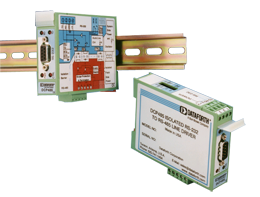World’s Smallest Fully Functional Isolated Analog Signal Conditioner
Press Release
Release Date: Jan 3 2005
 Dataforth Corporation of Tucson, Arizona, announces the introduction of its new SensorLex® 8B isolated analog signal conditioners. Developed in response to customer requests worldwide for a smaller, lower cost isolated signal conditioner, the SensorLex 8B more than meets the need, providing Instrument Class® performance in a package 20% the size of competing modular products. In fact, given its high performance, low cost, and small size, Dataforth's new 8B family represents a true technological breakthrough.
Dataforth Corporation of Tucson, Arizona, announces the introduction of its new SensorLex® 8B isolated analog signal conditioners. Developed in response to customer requests worldwide for a smaller, lower cost isolated signal conditioner, the SensorLex 8B more than meets the need, providing Instrument Class® performance in a package 20% the size of competing modular products. In fact, given its high performance, low cost, and small size, Dataforth's new 8B family represents a true technological breakthrough.The small size is ideally suited for embedded or portable applications such as mobile test stands, COTS military and defense applications, miniaturized security and surveillance systems, embedded process controls for semiconductor manufacturing equipment, and any other embedded industrial data acquisition system. With the SensorLex™ 8B, it is now possible to incorporate high-performance modular I/O on a per-channel basis for any embedded monitoring or measurement and control system; in addition, because the 8B provides an Instrument Class® analog output, it makes interfacing to almost any PC/104, CompactPCI, VMEbus, or proprietary data acquisition system board very easy.
The 8B line of miniature isolated analog signal conditioners provides 15 family groups with a total of 95 models that interface to a wide variety of voltage, current, temperature, position, frequency, and strain measuring devices. Housed in a solidly potted thermoplastic plug-in-the-panel package measuring only 1.11 x 1.65 x 0.4 inches (28.1 x 41.9 x 10.2mm), the 8B's industrial enclosure provides excellent impact properties, dimensional stability over temperature, chemical resistance, and a flammability rating of UL-94 V-0. The line will also be available in a DIN mount configuration in the near future.
Design-in accessories include a selection of backpanels (2, 4, 8, and 16 channels) that provide screw-terminal inputs and outputs as well as a DB25 header connector. The DB25 header can be matched with a 1, 2, or 7 meter cable to connect sensors and transducers to an external 25 screw-terminal interface board. Moreover, a power supply module in the same 8B form-factor is offered to accommodate input voltages of 12 to 36VDC and provide 5VDC output at 2A to power any combination of 8B signal conditioners. The 8BPWR module plugs into its own socket on the backpanel, which protects the power supply module from transients and reverse wiring errors.
The 8B's fully functional Instrument Class performance provides superior specifications such as 0.05% accuracy (includes nonlinearity, hysteresis, and repeatability), 0.02% linearity, 3-pole filtering, 1500Vrms isolation, and low output noise.
The 8B can interface to a broad spectrum of analog signals, including millivolt, volt, milliamp, thermocouple (linearized and nonlinearized), RTD, potentiometer, slidewire, strain gage, frequency, and 2-wire transmitter. Available analog output modules provide a wide selection of current and voltage output ranges.
Voltage input conditioners accept signals from +/-10mV to +/-60V, and current input conditioners accept signals of 0/4 to 20mA. Accepted thermocouple types are J, K, T, R, and S. Type Pt 100 RTDs can be 2-, 3-, or 4-wire. Potentiometer inputs can range from 0-100 ohms to 0-10k ohms. Strain gage transducers can have a resistance range of 100 ohms to 10k ohms, with sensitivities of 2mV/V, 3mV/V, or 10mV/V. Frequency input signals can be TTL or zero crossing with ranges from 0-500Hz to 0-100kHz. The 2-wire transmitter module provides loop power and accepts a 4 to 20mA input signal.
Additional models offer isolated field-side current and voltage outputs. Current output ranges are 0 to 20 and 4 to 20 milliamp, while voltage output ranges are 0 to 10V and +/-10V. Accuracy rating is +/-0.05%. Linearity is +/-0.02%. All modules have excellent stability over time and do not require recalibration.
Linearization of thermocouple signals is accomplished by a hardware implemented piece-wise approximation technique. The difference between sensor nonlinearity and the linearization provided by the 8B module is specified as conformity error. 8B modules use up to five segments to correct nonlinearity, which results in conformity errors as low as +/-0.015% span. Cold junction compensation error for thermocouple inputs is +/-0.5°C at 25°C ambient.
Signal bandwidth is 3Hz for most models, the exceptions being 100Hz for current output modules and 20kHz for high bandwidth voltage input modules. Output noise is as low as 250µVrms on the low bandwidth models.
Each 8B module isolates the field-side input or output signal with an optical isolation barrier rated at 1500Vrms. Common-mode rejection is 120dB; by incorporating a 3-pole filter, normal-mode rejection is 70dB at 60Hz. Additionally, field-side inputs or outputs are protected against accidental connection of line voltages up to 240VAC.
Operation and storage temperature is -40°C to +85°C, and relative humidity range is zero to 95% noncondensing. All models meet the requirements of EN61000-6-4 (radiated/conducted emissions) and EN61000-6-2 (ESD/RF/EFT immunity). For operation in hazardous environments, North American Class I, Division 2, and European Group II, Category 3, approvals are pending.
Dataforth Corporation was established in 1984 and is a worldwide leader in the design and manufacture of signal conditioning, data acquisition, and data communications products for industrial and institutional markets. The company is ISO9001:2015 registered and offers a broad range of analog and digital I/O modules, 2-wire transmitters, data acquisition systems, industrial data modems, and modem systems.
For additional information and pricing, call 800-444-7644 toll-free, or e-mail at sales@dataforth.com.
Original release: January 3, 2005
Was this content helpful?
Thank you for your feedback!






